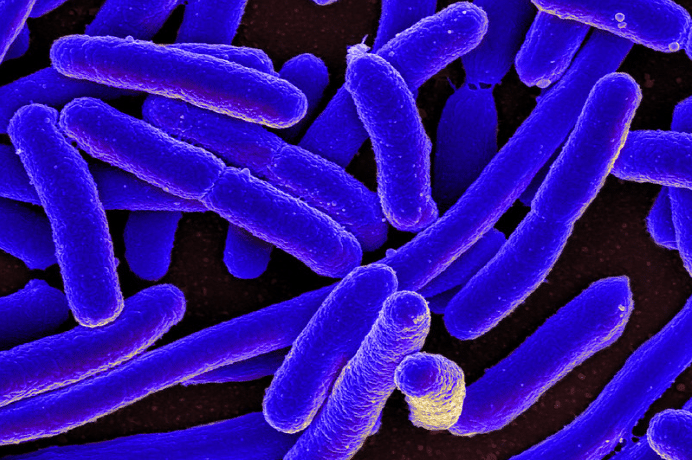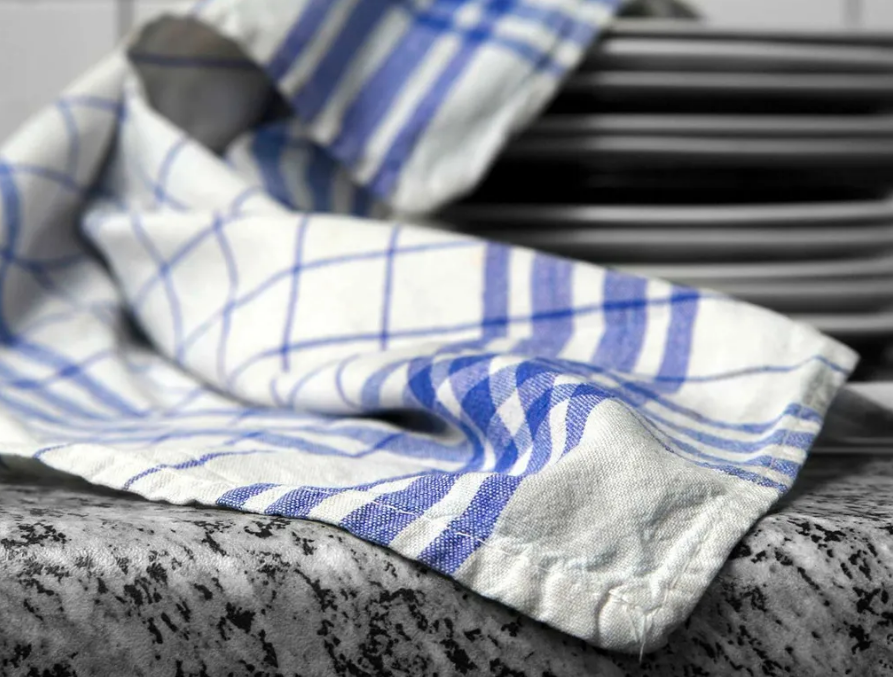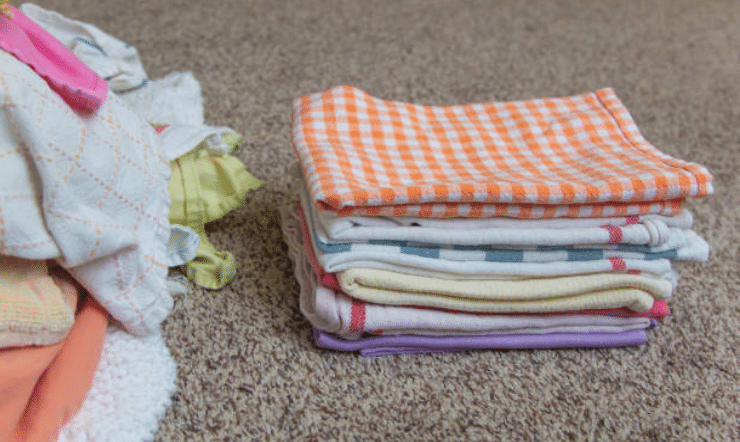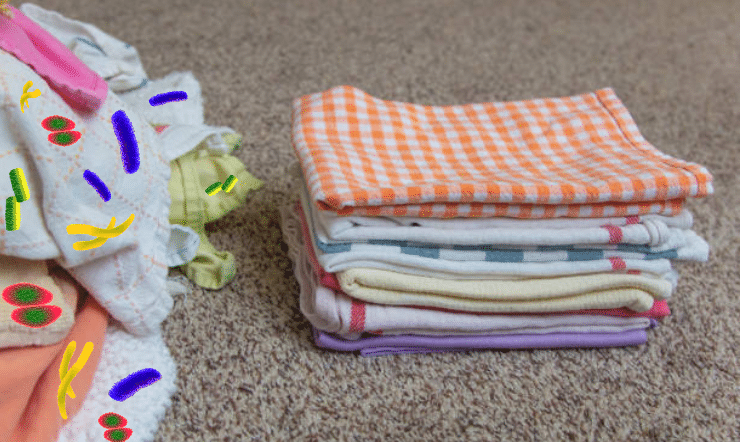In a kitchen, emphasis is often placed on hygiene. Therefore, our household appliances, utensils and work surfaces must be ultra-clean! However, the same cannot be said for our dirty tea towels and rags. Often used in various ways and repeatedly: wiping surfaces and dishes, drying hands, cleaning, etc., they are nevertheless key elements in the cleanliness of this room. However, it turns out that our good old dirty tea towels are among the worst breeding grounds for bacteria and microbes in the kitchen. Find out why and learn how often and how to maintain them.
Dirty tea towels, these bacteria nests which show traces of human excrement and increase the risk of food poisoning
We owe this frightening news to researchers at the University of Mauritius. During the annual meeting of the American Society of Microbiology from June 7 to 11, 2018 in Atlanta, they presented their study on our kitchen rags… and “the rag burns”! In fact, they collected around a hundred tea towels after a month of use, accompanied by a questionnaire for families. Here’s what they discovered:
- 49% of tea towels carried bacteria
- 37% had fecal coliforms (yes, yes, you understood correctly… traces of human excrement! This can be explained by the fact that these volatile bacteria go into the air after flushing the toilet)
- Add to this 36.7% enterococcus faeciuman intestinal bacteria that hydroalcoholic solutions cannot destroy
- Finally, 14% had staphylococcus aureushence the risk of poisoning.

Also, note that these bacteria can sometimes lead to more serious conditions, even death. Furthermore, they found more enterococcus in the vegetarian families. On the other hand, the tea towels non-vegetarian families had more fecal coliforms and staphylococcus aureus!
So, how often should you wash your tea towels to avoid risks? And what are the maintenance tips?
According to the researchers, the more children there are in a family, the more bacteria there are ! They also warn homes where there are elderly or fragile people. Apparently, you should ideally change your cloth… every day. Otherwise, the grand maximum would be two or three days. Suffice it to say that few households follow these recommendations… Also, scientists recommend a washing at 60° to eradicate bacteria. Another thing, they recommend good drying between two uses or the use of disposable paper towels to avoid spreading (not very eco-friendly…). Besides, it is better to scrupulously keep a cloth for each thing: one for the dishes and one for the hands.

How to properly clean and disinfect your kitchen rags and towels?
To effectively clean and disinfect kitchen cloths and towels, it is essential to follow a few key steps to ensure they are clean and minimize the growth of bacteria.
Carry out regular washing
Washing kitchen rags and towels regularly is crucial to prevent the build-up of dirt and bacteria. To do this, as said above, wash the rags and tea towels at a temperature of at least 60°C. A high temperature is necessary to kill the majority of bacteria and other microorganisms. Furthermore, prefer to wash them separately from clothingespecially those that may be delicate or different colors to avoid cross-contamination.
Furthermore, baking soda is a natural cleaning product that helps neutralize odors and eliminate stains. Add half a cup to the wash cycle with your regular laundry detergent. For stubborn stains, make a paste with baking soda and water, apply it to the stains and leave for 15-20 minutes before washing. The result will be impeccable.

Disinfection of rags with natural household products
For effective disinfection, it is important to use specific detergents. However, it is better avoid bleach which damages rags and can leave marks which will then be found on dishes and kitchen surfaces, which is not very healthy. As for commercial disinfectant, it is rather expensive. A natural alternative is to add a cup of white vinegar to the rinse cycle. Vinegar indeed has disinfectant and deodorant properties. Similarly, you can use lemon juice, known for its antibacterial and whitening properties as well as its pleasant scent. To do this, squeeze the juice of several lemons into a liter of hot water. Then soak the rags and dish towels in this solution for 30 minutes to an hour. For maximum effectiveness, after soaking, let them dry in the sun.
There are also other techniques than vinegar or lemon to disinfect laundry without harsh chemicals. Boil the rags and tea towels is notably an old but effective method. To do this, fill a large pot with water and bring it to a boil. Next, place the rags and dishcloths in the boiling water and let them boil for 10 to 15 minutes. This will kill the majority of bacteria and germs. Finally, rinse with cold water and let dry completely. Essential oils such as tea tree, lavender or eucalyptus oil also have antibacterial and antifungal properties. Add a few drops of essential oil (10-15 drops) to a liter of hot water and soak rags and dishcloths in this solution for 30 minutes to an hour before washing them as usual.
Finally, disinfect cloths and sponges using a microwave is fast and efficient. This method kills bacteria with heat. Just make sure the cloth is thoroughly wet (this prevents it from catching fire). Next, place the damp cloth in the microwave and heat it on high for 1-2 minutes. Caution: Be careful when removing the cloth, as it will be very hot.
Good drying for all cloths
Proper drying of rags and tea towels is also crucial to avoid bacterial growth. Si possible, dry rags and tea towels in the sun. UV rays indeed have natural disinfecting properties. Otherwise, use a dryer on high heat to kill any remaining germs. In any case, make sure that rags and tea towels are completely dry before storing. Residual humidity could actually encourage bacterial proliferation.
Good daily maintenance of tea towels
In addition to regular washing, daily practices can help keep rags and dish towels clean. For example, change cloth or tea towel every day or after each intensive use. Additionally, you can rinse cloths and dish towels in hot water after each use to remove food residue and bacteria. Additionally use a rotation of rags and tea towels to ensure they don’t stay wet or dirty for too long. Finally, proper storage also contributes to the cleanliness and longevity of rags and dishcloths. SO, store them in a dry, well-ventilated area to avoid mold.
By following these steps, you can keep your kitchen rags and towels clean and sanitized, contributing to a more hygienic and safer kitchen.



